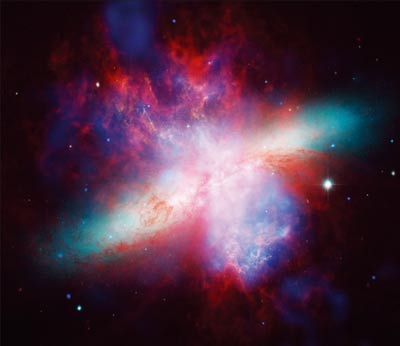
Composite image of the starburst galaxy M82 obtained with the Hubble, Spitzer and Chandra space telescopes. X-ray emission by Chandra (blue) and infrared light from Spitzer (red) complement Hubble images of ionized hydrogen emission (orange) and visible light (yellow-green).
Image credit: NASA, ESA, CXC and JPL-Caltech.
The detection of very-high energy (VHE, E> 100 GeV) gamma-rays from the starburst galaxy Messier 82 (M82) by the Very Energetic Radiation Imaging Telescope Array System (VERITAS) may help solve a 100-year-old mystery on the origin of cosmic rays. It provides new evidence for cosmic rays being powered by exploding stars and stellar winds.
The sensitivity to VHE gamma-rays of the current generation of Cherenkov telescope arrays has opened a new era in the study of cosmic rays. The gamma-rays are produced by the interaction of cosmic rays – particles that zip through space at nearly the speed of light – with interstellar matter and ambient radiation. As the induced gamma-rays are not deflected by magnetic fields in the galaxy, they have the advantage of pointing back to their production sites.
The detection of VHE gamma-rays from the rim of the supernova remnant RX J1713.7-3946 by the High Energy Stereoscopic System (HESS) was already strong evidence for cosmic-ray acceleration in the shock wave launched by the supernova explosion (CERN Courier January/February 2005 p30). Another piece of evidence now comes from VERITAS, the northern hemisphere analogue to HESS. The array of four 12-m Cherenkov telescopes located in Arizona was pointed towards the “Cigar Galaxy” M82 for 137 hours between January 2008 and April 2009. This exceptional observation effort finally paid off with a firm detection (4.8σ) of this galaxy located 12 million light-years away in the direction of the constellation Ursa Major, near the well known Big Dipper or Plough. M82 was a prime target for VERITAS because it was predicted to be the brightest starburst galaxy in terms of gamma-ray emission and was out of reach for HESS, located too far south in Namibia.
VERITAS observed less than one gamma-ray photon from M82 an hour. With only 91 events, the spectrum of the VHE emission is quite poorly determined. It was, however, found that both the intensity and the photon index (Γ = 2.5±0.8) in the 0.9–5 TeV range are consistent with a recent model prediction for M82. In this energy range, the dominant contributors to the VHE gamma-ray emission are supposed to be inverse-Compton scattering from cosmic-ray electrons and the decay of neutral pions originating from the interaction of ions (mostly protons) with atoms in the interstellar medium. The inferred density of cosmic rays in the central core of M82 is about 500 times that on average in the Milky Way. The Hubble telescope revealed that this region of about 1000 light-years in diameter contains hundreds of young, massive star clusters. The wind of the most massive stars and a supernova rate 30 times higher than in our galaxy are supposed to accelerate enough cosmic-ray particles to produce the VHE gamma-ray radiation observed in M82.
Until now, the only sources of VHE gamma-rays detected outside the Milky Way were active galactic nuclei, where the observed radiation is supposed to be emitted by a relativistic jet launched by a super-massive black hole. The detection of the non-active galaxy M82 – as well as that of NGC 253 reported in September by the HESS collaboration – is a new breakthrough for Cherenkov telescope arrays.








